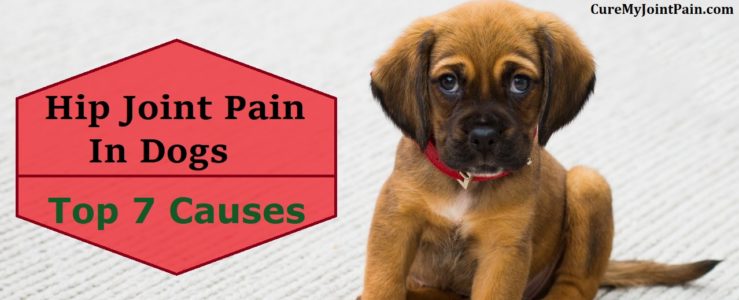Top 7 Causes Of Hip Joint Pain In Dogs

In the last 5 years, hip joint pain in dogs became a very serious problem. It’s not just humans suffering from arthritis, it’s also dogs. Every vet deals with at least one case per day. But are the causes the same as for us?
What exactly produces this hip joint pain in dogs? Why are some dogs more exposed to this problem? And are there any risk factors dog joint pain? Let’s take a look at the most common 7 causes.
1. Arthritis
 Just like humans can develop arthritis, so can dogs. In most cases, we’re talking about osteoarthritis. Rheumatoid and auto-immune forms of arthritis are more rare in dogs, but they do exist.
Just like humans can develop arthritis, so can dogs. In most cases, we’re talking about osteoarthritis. Rheumatoid and auto-immune forms of arthritis are more rare in dogs, but they do exist.
Now, if you’re wondering why osteoarthritis appears, it’s just like in humans. Growing older makes your joints and cartilages weaker, and that’s what we call osteoarthritis.
This condition can weaken several joints of your dog’s body, including the hip ones. That’s why hip pain is one of the most common signs that your dog has arthritis. According to a study, around 20% of all dogs suffer from arthritis at one point. It usually happens when they grow older, but some forms can also appear in younger dogs.
2. Hip Dysplasia
This painful condition is a very frequent cause of hip pain in dogs. In this case, the problem lies in the hip joint. Instead of sliding in properly, it rubs against the bone. You can imagine how painful and harmful that it, especially after a while.
What’s interesting is that this condition can be genetic. However, if your dog’s parents suffered from hip dysplasia, there are still high chances that your dog never develops the disease. It matters a lot how active he is and the things he eats. Obesity can be a risk factor for hip dysplasia, so make sure you keep his weight under control.
Another thing to keep in mind is that large breeds are more likely to get hip dysplasia than smaller ones. But fortunately, this condition can be prevented with a correct diet and regular exercise. So don’t keep your dog inside all day and let him go out, run and stay in shape.
3. Genetics
 Maybe you haven’t heard that too often, but genetics play a big part in every dog’s health. Many health problems can be inherited from his parents. That’s the case of joint pain as well.
Maybe you haven’t heard that too often, but genetics play a big part in every dog’s health. Many health problems can be inherited from his parents. That’s the case of joint pain as well.
If it’s hip dysfunction causing your dog’s pain, genetics is surely involved. Also, if he suffers from an auto-immune form of arthritis, he may also have inherited that.
However, you don’t always know where your dog comes from. Maybe you bought it from a pet shop, you got it as a gift or you simply found him on the street. Sometimes you just can’t know what happened in the past. And in these cases, there’s nothing you can do.
But if you know your dog has a family history of a certain condition, make sure you keep an eye on him. Any small symptom should be a warning sign to take him to a vet.
4. Osteodystrophy
HOD or hypertrophic osteodystrophy is a condition that affects young dogs from large breeds. Though it doesn’t affect the hips, your dogs will feel the pain in that area. This condition prevents the large bones from growing correctly, and sometimes they can become very swollen and painful.
Fortunately, most dogs that develop osteodystrophy don’t need any treatment because their bones correct automatically. But in rare cases, the malposition is so severe that it doesn’t correct on its own.
So if you have a large breed dog that seems to be in bad pain, take him to the vet as soon as possible. It may be a minor cause, but it can also be osteodystrophy and that’s a serious issue.
5. Panosteitis
 This is another “growing” condition that appears more in larger breeds. If your dog has panosteitis, it means his long bones are slightly inflamed and his legs and hips are very painful. Fortunately, the inflammation doesn’t have any serious cause and it usually goes away on its own.
This is another “growing” condition that appears more in larger breeds. If your dog has panosteitis, it means his long bones are slightly inflamed and his legs and hips are very painful. Fortunately, the inflammation doesn’t have any serious cause and it usually goes away on its own.
But how do you know it’s panosteitis behind your dog’s pain? Well, it’s hard to tell for someone who’s not a vet. But typically, the pain appears suddenly and it’s pretty sharp.
So if you notice your dog is suddenly in terrible pain, without any previous symptom, it may be panosteitis. However, it rarely appears in dogs more than 2 years old. In fact, more than 75% of the cases are in the first year.
So young age, large breed and fast growth are risk factors for this condition. Genetics also plays a part, but you can’t always know the history of your dog’s family.
6. Osteochondritis Dissecans
Here’s another cause of joint pain that you can see in humans as well. It’s hard to explain this condition, but to put it simply, it appears when there’s an excess cartilage that develops at the end of the bone. As a result, the normal cartilage becomes weaker and it can’t protect the bone properly anymore.
Once again, large breeds are affected more by this condition. It’s probably because they tend to grow faster, if you ask me.
The good news is that OCD tends to go away on its own in dogs, unlike in humans. However, there are some rare cases when it doesn’t. In this situation, surgery remains the best solution.
7. Legg-Calve-Perthes Syndrome
If you thought smaller breeds are safe from hip joint pain, take a look at this condition. LCP disease is one of the few that tends to affect smaller breeds, and it’s also one of the most severe from this list.
When your dog has this condition, it means his hip starts disintegrating and the joints around it become swollen. What’s interesting is that the cause remains unknown even today. And unfortunately, LCP disease also affects humans, children more precisely.
The best treatment for this syndrome remains surgery, especially if your dog has a severe form. That’s something only X rays can tell, so make sure you take him to a vet as soon as possible.
Is Your Dog Suffering From One Of These Problems?
If you noticed your dog is struggling with walking, he prefers to lay down and he’s not as active as before, there’s clearly something wrong. In most cases, it’s because he’s in pain. And judging after these signs, it’s his hips and legs hurting.
But the question is, what’s the cause of this pain?
Usually, it’s arthritis, but your dogs needs to be at least in his mid years. If that’s not the case, take a look at his breed. If he’s a larger dog, there may be several causes like hip dysplasia or ostheochondritis disecans. On the other hand, if he’s a small breed, things might be more serious.
But either way, if you notice the pain doesn’t go away in a few days, take your dog to a vet. It’s pretty clear the joint pain has a real cause, other than fatigue or effort.
So what do you think could be the cause of your dog’s hip joint pain? Do you know any other frequent cause, other than these 6? Let me know your answer in a comment and I will reach out to you.




